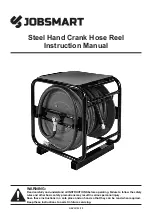
– 8 –
1. Lift the saw up from inside the water tray.
2. Flush water into the tray while holding it upright to
remove any sludge buildup.
3. Replace the saw back into the tray.
See Figure 4.
1. Ensure that the water tray is empty and dry.
2. Unplug the power cord and store it in the
water tray.
3. Secure the cutting table to the front of the saw
using the table retention device.
DO’S
• Inspect blades daily for cracks or uneven wear.
• Always use appropriate blade for material
being cut.
• Inspect arbor shaft for uneven wear before
mounting blade.
• Always use blades with the correct arbor shaft
size.
• Ensure that blade is mounted in the correct
direction.
• Use proper safety equipment when operating
the saw.
• Always have a continuous flow of water on
both sides of blade.
• Secure the blade to the arbor with a wrench.
DONT’S
• Do not operate the saw without safety guards
in position.
• Do not operate the saw with blades larger or
smaller than 7".
• Do not cut dry with blades marked “Use Wet”.
• Do not exceed manufacturer’s recommended
maximum RPM.
• Do not force blade into material. Let blade cut
at its own speed.
DO’S
• In addition to the following, always follow wet
recommendations.
• Use appropriate blade for material being cut.
• Inspect segment blades for segment cracking
or loss.
• Do not use damaged blades.
• Use proper safety equipment when operating
the saw.
DONT’S
• In addition to the following, always follow wet
recommendations.
• Do not make long cuts with dry blades. Allow
them to air cool.
• Do not use the edge or side of blade to cut or
grind.
• Do not attempt to cut a radius or curve.
• Do not cut too deep or too fast into the
material.
• Do not cut any material not recommended by
blade manufacturer.
TRANSPORTING THE SAW
WET CUT BLADES
DRY CUT BLADES
Figure 4
vii. PROPER BLADE USE
CLEANING THE WATER TRAY






































